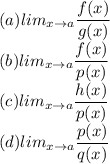
Mathematics, 28.06.2020 02:01 keigleyhannah30
Consider the given limits (a is a constant, f(x) ≥ 0). lim_(x->a) f(x) = 0 lim_(x->a) g(x) = 0 lim_(x->a) h(x) = 1 lim_(x->a) p(x) = infinity lim_(x->a) q(x) = infinity Evaluate each limit below. If a limit is indeterminate, enter INDETERMINATE. (If you need to use -[infinity] or [infinity], enter -INFINITY or INFINITY.)

Answers: 2


Another question on Mathematics

Mathematics, 21.06.2019 17:30
When the solutions to each of the two equations below are graphed in the xy-coordinate plane, the graphs of the solutions intersect at two places. write the y-cordninates of the points of intersection in the boxes below in order from smallest to largest. y=2x y=x^2-3
Answers: 1

Mathematics, 21.06.2019 19:00
John used linear combination to solve the system of equations shown. he did so by multiplying the first equation by -3 and the second equation by another number to eliminate the x-terms. what number did jonas multiply the second equation by? 4x-6y=23x+5y=11
Answers: 2

Mathematics, 21.06.2019 19:30
The length of a shadow of the building is 36m. the length of the pole, which is perpendicular to the ground, is 1.9m. the length of the pole's shadow is 1.52m. what is the height of the building?
Answers: 1

Mathematics, 21.06.2019 23:30
In a study of the relationship between socio-economic class and unethical behavior, 129 university of california undergraduates at berkeley were asked to identify themselves as having low or high social-class by comparing themselves to others with the most (least) money, most (least) education, and most (least) respected jobs. they were also presented with a jar of individually wrapped candies and informed that the candies were for children in a nearby laboratory, but that they could take some if they wanted. after completing some unrelated tasks, participants reported the number of candies they had taken. it was found that those who were identiď¬ed as upper-class took more candy than others. in this study, identify: (a) the cases, (b) the variables and their types, (c) the main research question, (d) identify the population of interest and the sample in this study, and (e) comment on whether or not the results of the study can be generalized to the population, and if the ď¬ndings of the study can be used to establish causal relationships.
Answers: 2
You know the right answer?
Consider the given limits (a is a constant, f(x) ≥ 0). lim_(x->a) f(x) = 0 lim_(x->a) g(x) = 0...
Questions



Biology, 22.08.2019 06:30

Mathematics, 22.08.2019 06:30

Mathematics, 22.08.2019 06:30

Social Studies, 22.08.2019 06:30





Social Studies, 22.08.2019 06:30


History, 22.08.2019 06:30


Mathematics, 22.08.2019 06:30

History, 22.08.2019 06:30

Geography, 22.08.2019 06:30

History, 22.08.2019 06:30

Biology, 22.08.2019 06:30









